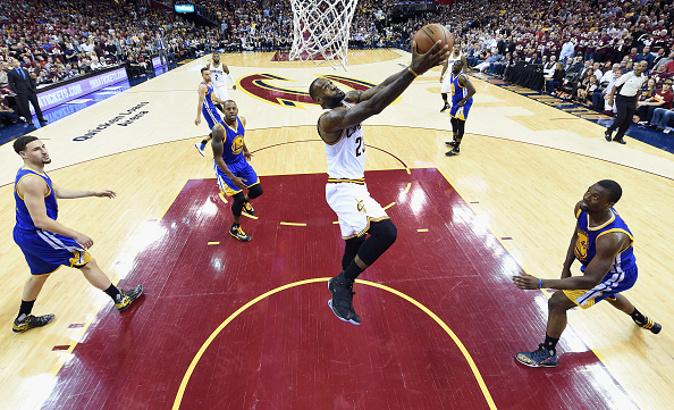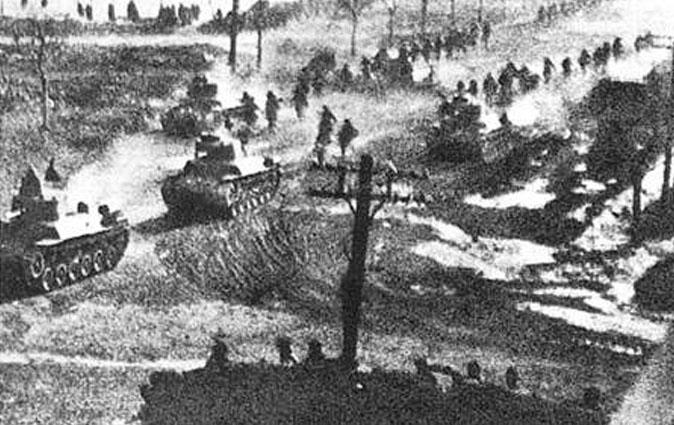The Cavaliers
Mindset and Focus
The first step in making a counterattack is having the right mindset. For any team down 0-2 in a series, Game 3 is a must-win game, and the Cavs made this very obvious with their actions last night. This starts with the team’s leader and heart and soul—Lebron James. All the way from pregame in the locker room, Lebron was firing teammates up and took a visible ‘follow my lead’ approach. Perhaps this is what Phil Jackson meant when he said that Lebron needed to be more like MJ. ‘Beast mode’ for Lebron is not limited to high level play on the court, but being a leader and having teammates believe they have nothing to fear because they have the best player in the world on their side.
Team Defense
In games 1 and 2, every player on the Cavs—Kyrie, Lebron, J.R.,—were burnt on defense, and consistently at that. This led to a lot of easy or uncontested shots, dunks, and layups for the Warriors. Remember: it wasn’t the Splash brothers that beat the Cavs in games 1 and 2 (11 and 18 points for Curry, 9 and 17 points for Thompson), but the Warriors’ ball movement and passing.
Coach Nick of BBallBreakdown expertly shows this in his video “How the Thunder and Cavs defend the same actions,” which clearly exposes the Cavs’ fragility on defense compared to the Warriors’ previous opponent.
But that was the story for games 1 and 2. Last night, an entirely different Cavs took the floor on defense through making quick rotations, expertly switching, trapping, and bumping Curry off screens, and rapidly closing out shooters who at first glance appeared open. Overall, the team was much much more physical. Curry was ultimately limited to 19 points—just 2 in the first half, Thompson to just 10 points, and Green to just 6 points. Golden State as a whole shot 42 percent from the field, compared to 52 percent for the Cavs, and 27 percent from three compared to 48 percent for the Cavs.
Kyrie Irving
Irving was getting a lot of flack after a lackluster game 1 and 2 with chants of “overrated” and “poor man’s Dwyane Wade.” Last night, Irving reminded us just how electrifying he can be right out of the gate, compiling 16 points in just the first quarter. Irving is always a threat to penetrate the lane through a dazzling array of moves, but unlike Wade, is also a very effective three-point and spot up shooter. Because he can hurt you from virtually anywhere on the floor, an unhesitant Irving opens up the offense for the entire Cavs team by lessening the workload for Lebron, opening up space for shooters, and drawing defenders so that even if he misses, the Cavs have a higher chance of collecting the offensive rebound.
Lebron James at the 4
With a full statline of 32 points, 11 rebounds, and 6 assists, James did a lot of things well last night, but such a line is quite conventional for James. The one thing that stuck out about the way the Cavs played James last night was putting him at power forward. This pits him directly against Draymond Green, which last night proved to be a horrible matchup for the latter. James’s athleticism poses great problems for Green, who noticeably had problems keeping James in front of him compared to the way Iguodala is able to handle James. Similarly, on the other side of the ball, Green has problems scoring on James. Suppressing Green is huge for the Cavs, as he is not only the emotional leader of the Warriors, but as the team’s distributor and playmaker, he is arguably the most pivotal player on the team. A limited Green makes it harder to get the ball to Curry and Thompson, which hugely limits the Warriors’ offensive effectiveness.
The Cavs also had success running James in the pick and roll. In the switch, James would often draw Curry, during which James would have no qualms backing Curry down and bringing the same physicality on offense that the team brought on defense.
The Rest of the Starters—Thompson, Jefferson, Smith
Thompson role does not need much exposition. He has always been one of the league’s best offensive rebounders, and last night had just about as many offensive rebounds (7) as the entire Warriors team (8). It’s deflating for any team when James gets the ball back after finally getting a defensive stop on him. If Thompson continues to play at this level, the Warriors may have to think twice about going to the rebounding-deficient small ball lineup they are famous for.
Thompson also excelled in the pick and roll with James or Irving. Thompson will in all likelihood score when left with a clear path to the rim, which makes it difficult for the Warriors, who may want to double up on James or Irving. Thompson ultimately finished with 14 points on 5-6 shooting, 13 rebounds, and a +21 plus-minus rating.
J.R. Smith is very dangerous when he is hot, and the Cavs also did a masterful job last night of getting him into a rhythm through a combination of collapsing the defense and precision passing from James. Smith finished with 20 points on 7-13 shooting and 5-10 shooting from distance.
Most importantly, Jefferson fits perfectly in his role as the team’s last scoring option. Jefferson provides a veteran’s presence and maturity on the court in getting done the things that need to be done, similar to Shane Battier’s role with the Heat championship teams. Particularly, last night we saw Jefferson fight for rebounds, and disrupt on defense with his length. Jefferson finished with 9 points and 8 rebounds.
Kevin Love
How the team plans to use Kevin Love going forward will no doubt be a big storyline before Game 4 on Friday. At a glance, it appears Love is a bad fit in the Cavs winning formula, for he is a high usage player that can be exposed on defense. Additionally, Thompson at center seems like a much better pair with James than a James-Love pairing, assuming the Cavs want to continue playing James at power forward. A good role for Love could possibly be as a sixth man off the bench—someone to fill the scoring void and against Golden States’ high scoring reserves (though it is unknown how Love feels about coming off the bench), or as a center to stretch the floor when Golden State goes small.
What About the Warriors?
In their loss, the Warriors played with uninspired and lackadaisical effort. The Warriors are now 2-6 in Game 3s over the past two seasons. But at the end of the day for the Warriors, its just one game. As we saw between Games 2 and 3 and throughout the playoffs, teams in the NBA can turn the tide in a jiffy.
But the Warriors have work to do. First of all, the splash brothers must get going, which is what ultimately turned around the Thunder series. Curry has to dominate and play like the unanimous MVP that he is; the 2 points in the first half was the subject of much chagrin last night. For Curry, playing well this means not only scoring , but being a playmaker—the Warriors can’t afford to always run their offense through Green. Curry’s deficiency in boosting teammates in the series is illustrated by Curry currently having more turnovers (15) than assists (13) over the three games. Sloppy offense was really a problem for the whole Warriors team last night, which was very unlike the polished offensive sets they ran in games 1 and 2.
Notable stat: Cavs beat the Warriors in points off turnovers 34-8 in Game 3. In Game 4, the Warriors will also looks to reciprocate the Cavs’ increased physicality, starting with bigs Bogut, Ezeli, and Green setting the tone with their rebounding and defense inside. The Warriors were out-rebounded 60-41 in Game 3.




